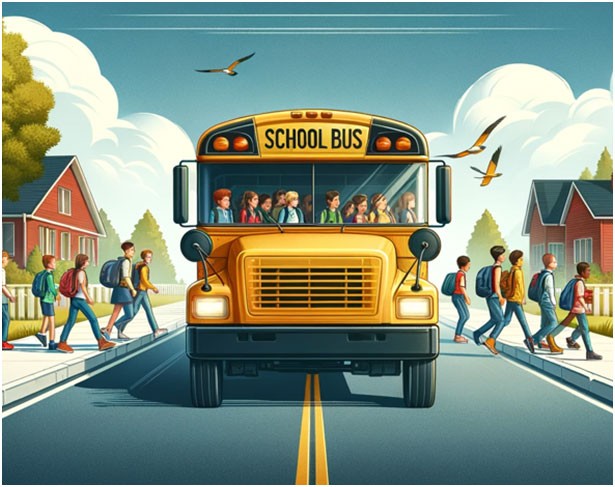
Image by Transfinder via Dall-E
School bus transportation is an integral part of the education system. It provides safe and reliable access for millions of students to and from their schools.
While not always the most glamorous aspect of education, the economics of school bus transportation plays a critical role in ensuring access to quality education. Incorporating school buses into the system is by far the safest option for student transportation. According to the National Highway Traffic Safety Administration, students are about 70 times more likely to get to school safely when taking a school bus instead of traveling by car. This safety advantage allows school systems to allocate resources effectively, balancing the need to cover all their responsibilities while ensuring student safety.
Balancing cost with service quality in school bus transportation is a complex challenge for districts. The updated 2022-2023 report from School Bus Fleet reveals nearly half a million school buses in the U.S. transport 20 million students over 2.7 billion miles annually, underscoring the significant financial and operational scale of this endeavor. To navigate these costs effectively, school districts must scrutinize various factors to achieve an optimal balance between affordability and the level of service provided, ensuring both fiscal responsibility and the safety and well-being of students.
This article will dive into this important subject with an overview of the costs associated with transporting students. Some are obvious, while others may be a bit more hidden. This will include an examination of the vehicle, personnel, regulatory, and operational costs that are sure to arise.
Through this review, school officials can hope to gain a clear understanding of everything they need to know to provide the best possible access to high-quality transportation for their student population.

Image by Dirk Wouters from Pixabay
The Cost of School Bus Transportation
Purchasing and maintaining a fleet of bright yellow school buses may often fall in the top five line-item expenses on an education organization’s books. How does this obligation break down into understandable chunks?
A Bird’s Eye View
Optimizing school bus operations is crucial for maximizing budgetary efficiency in transportation. With the cost of each school bus ranging significantly, effective management can lead to substantial savings. By focusing on efficient utilization and maintenance strategies, districts can enhance operational efficiency, reducing the overall financial burden. This approach not only supports financial sustainability but also ensures that transportation remains a reliable service for students, contributing positively to their educational experience.
While the initial purchase price is a definite factor, a long laundry list of ongoing expenses can make bus ownership a more costly proposition.
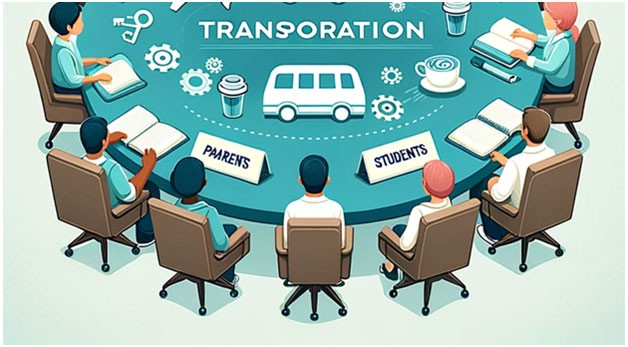
Image by Transfinder via Dall-E
The Key Stakeholders at the Table
One big factor that adds to the complexity of school bus policies is the number of voices that come into play in decision-making. Consider some of the unique viewpoints and priorities that these groups bring to the table.
- School District Administration:The district's top administrators may oversee transportation decisions and are concerned with budgetary constraints and educational quality.Responsible for managing the district's finances, the Chief Financial Officer will focus on cost implications and budget considerations.The Transportation Director is directly responsible for planning and managing the bus transportation system. They need to balance costs with safety and efficiency.
- School Board:Elected representatives set policies and approve budgets. They must consider the interests of the community and the best use of resources.
- Parents and Guardians:They are concerned about the safety, quality, and efficiency of transportation services, as well as any potential impacts on their children's education.
- Students:The well-being and convenience of students using the bus services are crucial. Safety and comfort are essential factors for students. Having a comfortable and efficient method to arrive at school can affect test scores and attendance patterns.
- Bus Drivers and Staff:Bus drivers, mechanics, and other transportation staff have firsthand knowledge of the operational aspects of the system. They are concerned with job security, working conditions, and student safety. Even teachers may have input on the transportation system, as it can influence punctuality and attentiveness within the classroom.
- Bus Contractors and Service Providers:Private bus companies or contractors may be involved in providing transportation services to the district. They have a financial interest in securing contracts and delivering quality service.
- Local Community:Community members who do not have children in the school district may have concerns about the impact of transportation decisions on local traffic, property values, and quality of life.
- State and Federal Authorities:State and federal education agencies may provide funding and regulations that impact transportation decisions. Compliance with safety regulations and eligibility for funding are important considerations.
- Environmental organizations, while advocating for sustainable transportation options, recognize the efficiency of school buses in reducing individual car usage. Transporting many students simultaneously, school buses significantly lower the environmental footprint compared to multiple personal vehicles. This collective mode of transportation aligns with the goals of reducing emissions and promoting greener alternatives, underscoring the environmental benefits of optimizing school bus use for student transportation.
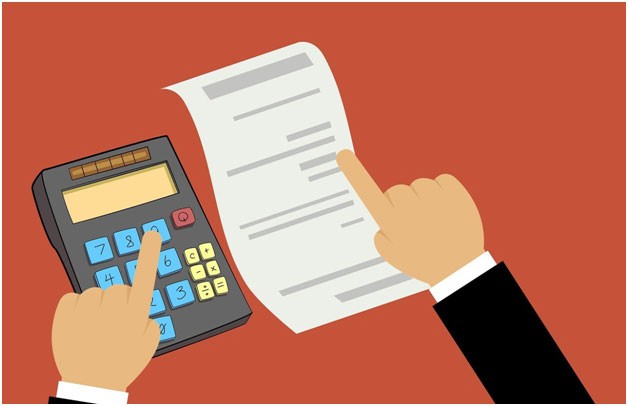
Image by Mohamed Hassan from Pixabay
Factors Influencing the Cost of School Bus Transportation
Running school buses involves a range of costs, encompassing various aspects of the transportation service. We can organize these into the following broad categories.
VEHICLE COSTS
The initial cost of acquiring school buses is a significant expense. Buses need to be well-maintained, durable, and equipped with safety features, which can drive up their purchase price.
Regular maintenance, inspections, and repairs are essential to keep school buses in good working condition. This includes costs for servicing engines, brakes, tires, and other components. Preventive maintenance can help reduce the need for costly repairs down the road.
Fuel costs are a substantial part of the budget. School buses often run on diesel or gasoline, and fuel prices can fluctuate, impacting the budget.
Insurance costs cover liability, vehicle, and property damage coverage. School districts must carry sufficient insurance to protect against accidents and other unforeseen events.
Vehicles have a finite lifespan, and their value depreciates over time. School districts need to account for this depreciation when planning for future bus replacements.
If a district takes out loans or leases school buses, it will incur financing costs, which include interest payments and other related expenses. These sometimes overlooked fees will add to the total cost of ownership.
PERSONNEL COSTS
School bus drivers play a crucial role in transporting students safely. Their salaries, benefits, and training costs are part of the personnel expenses. This also includes overtime pay, if applicable.
In some cases, school buses have aides or monitors on board to assist students with special needs. The salaries and benefits of these staff members add to personnel costs.
Personnel expenses may include the salaries of administrative staff responsible for managing the transportation department, including dispatchers, supervisors, and support staff. Failing to account for these costs means that otherwise usable buses may lie dormant.
REGULATORY COSTS
School buses must adhere to strict safety regulations, which may necessitate costs for inspections, licensing, and compliance with state and federal laws.
School buses require specialized safety equipment, including stop signs, flashing lights, and emergency exits. Compliance with safety regulations can entail the purchase, installation, and maintenance of such equipment.
Ensuring that drivers and other transportation staff meet the required standards often involves background checks and training programs. These can incur additional costs.
OPERATIONAL COSTS
Creating efficient bus routes, scheduling, and route optimization software may be required to minimize operational costs and improve service quality.
Expenses related to communication tools, such as two-way radios or GPS tracking systems, and the associated data costs can be part of operational expenses.
Operational costs may include general administrative overhead, such as office space, utilities, and equipment for managing the transportation department.
Given that school districts are mandated to provide bus service and cannot opt out of these operational expenses, it is understood that costs such as fuel, oil, cleaning supplies, and spare parts are essential. These components are integral to maintaining a reliable and efficient transportation service, ensuring that students are transported safely and effectively as required by state regulations.
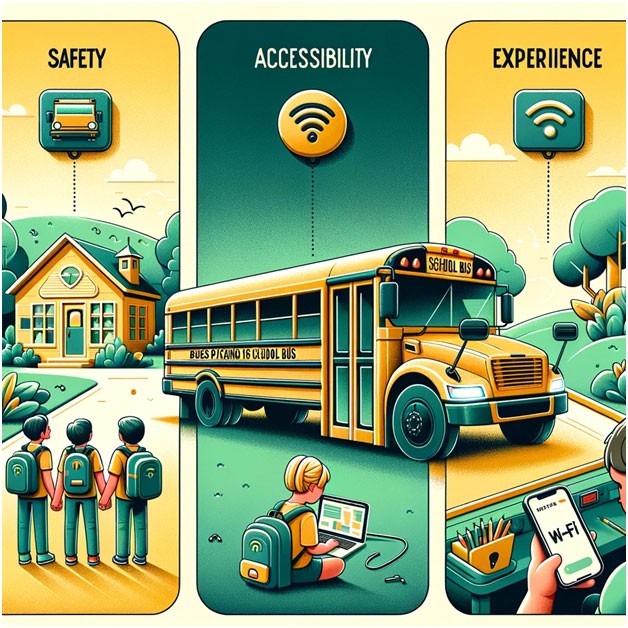
Image by Transfinder via Dall-E
Balancing Cost with Quality
Districts face a delicate ballet of equalizing their attention to cost and quality of service when it comes to student transportation. Failing to achieve this equilibrium can lead to troubling scenarios.
Costs may inflate so much that districts cannot afford to maintain necessary standards. This can lead to public outcry and a damaged reputation, not to mention the impact on students themselves. Consider three major balancing points.
1. Safety
School buses are among the safest modes of transportation for students. They are designed with safety in mind, featuring reinforced structures, flashing lights, stop signs, and specialized training for drivers. This ensures that students are protected during their journeys to and from school.
Technological advancements are reshaping the features available on school buses, primarily focusing on enhancing safety and efficiency. While the integration of Wi-Fi, cameras, and driver-assistive technologies like lane assistance are not widespread, the industry has seen the adoption of sensors for pedestrian detection and collision prevention. These innovations contribute to the evolving landscape of school transportation, ensuring that safety remains a top priority as new technologies become feasible and are adopted.
2. Accessibility
School buses are the primary mode of transportation for many students, especially in rural and suburban areas where walking or using public transit might not be viable options. They bridge the gap between home and school, ensuring that students can access education regardless of their geographical location.
By providing free or low-cost transportation, school buses promote equity in education. They ensure that students from various socioeconomic backgrounds have equal access to educational opportunities.
3. Student Experience
In their journey to find a balance between price and service, districts shouldn’t discount the end-user experience. While a bus ride may not be particularly exciting – except as a novel experience for a brand-new bus rider, which quickly fades – it can be a comfortable and even enjoyable part of the day.
Modern features like Wi-Fi access allow students to continue their schoolwork away from their classroom. This is especially useful for families that may lack such access at home.
GPS tracking capabilities keep parents informed on the whereabouts of their children and give them peace of mind and a greater ability to plan their day.
While electric-powered vehicles offer environmental benefits and a quieter ride experience, their impact on overall cost-effectiveness needs further exploration.
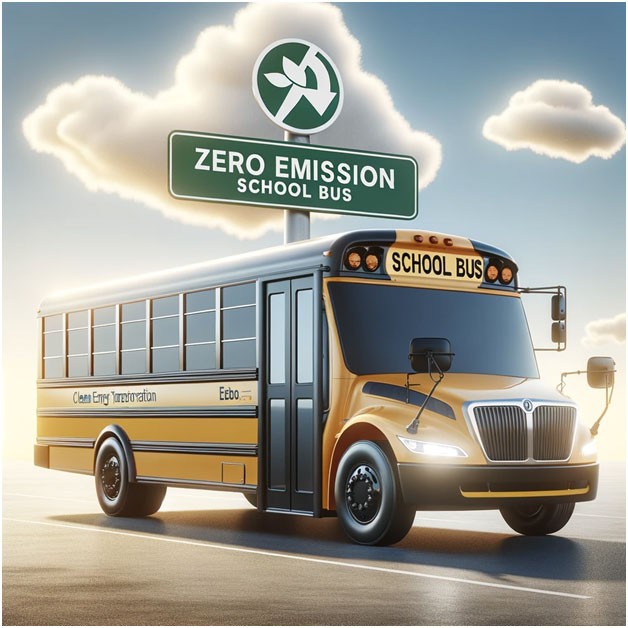
Image by Transfinder via Dall-E
Real-World Example
Take a look at New York State’s bus fleet. The state passed a law mandating zero emissions by the year 2035. With more than 50,000 buses, New York maintains nearly 10% of the entire country’s fleet of buses.
The statewide transition team eyed electric buses as a potential way to address pollution, but this answer wasn’t without its drawbacks. New electric buses cost twice as much as their diesel counterparts in some cases.
Some savings were realized through the lower operating costs of electric buses. One estimate puts the charging cost of electric buses at between $0.14 and $0.22 per mile. Diesel fuel may cost closer to $0.36 per mile. Of course, these costs are highly variable and can’t be guaranteed in every locale.
The New York education system found that other costs shrunk the expected savings. For example, batteries for electric vehicles continue to run as high as $50,000 for a replacement. A new diesel engine may cost about $10,000.
Time will tell whether the state will be able to meet imposed mandates. However, it is quite clear that the transition will incur a substantial cost in vehicle, maintenance, and infrastructure modifications.
These considerations highlight the complex challenges faced by school systems nationwide as they strive to optimize transportation services for students and communities, while balancing cost-effectiveness with quality.
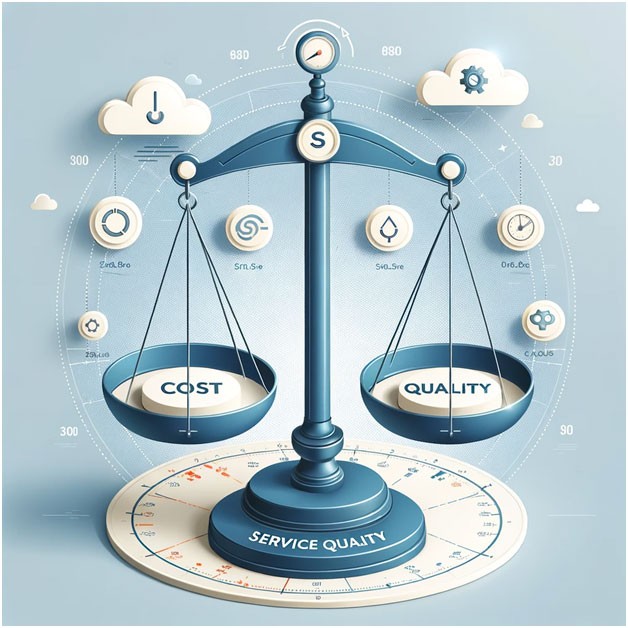
Image by Transfinder via Dall-E
Solutions for Balancing Cost and Quality
What avenues do schools have to reach an equitable give-and-take between cost and quality of service for student transportation? Many emerging policies and tech advances help education institutions reach their goal of a sustainable model.
ROUTE OPTIMIZATION
School districts can employ modern technology and data analytics to optimize bus routes. By ensuring that buses take the most efficient routes and minimize the distance traveled, districts can reduce fuel consumption and maintenance costs.
Optimizing routes to minimize travel time and maximize passenger capacity offers a more significant impact on operational efficiency compared to minor adjustments like reducing left turns.
FLEET MANAGEMENT
Regular maintenance of the school bus fleet is crucial to prevent costly breakdowns. Investing in fleet management software can help districts keep track of maintenance schedules and reduce unexpected repair costs.
One benefit of tracking metrics within a fleet is that districts can begin to discern the lifecycle cost of bus ownership – an overview of the purchase price plus operating costs over the expected life of the vehicle.
ENERGY EFFICIENCY
As environmental concerns become more prevalent, school districts can explore alternative fuel sources or adopt electric buses to reduce fuel costs and carbon emissions over the long term.
CONTRACTING AND OUTSOURCING
Some school districts choose to outsource their transportation services to private companies, which can lead to cost savings through economies of scale and specialized expertise. However, districts must carefully consider the potential trade-offs, such as loss of control over service quality.
EFFICIENT SCHEDULING
Balancing bus schedules to minimize downtime between trips and making the most of existing resources can contribute to cost savings.
Additionally, adjusting school start times to allow for more efficient bus runs can reduce transportation expenses. Staggered routes may mean that a district can transport the same number of students in a slightly longer timeframe but with fewer vehicles.
SAFETY TRAINING AND STANDARDS
By investing in driver training and enforcing strict safety standards, school districts can minimize accidents and reduce liability costs. A well-trained and safety-conscious workforce is an essential factor in a seamless transportation operation.
COMMUNICATION AND TECHNOLOGY
Utilizing communication tools like GPS tracking and mobile apps can enhance the overall service quality by providing real-time information to parents and school administrators, ensuring timely arrivals and departures.
COLLABORATION AND COORDINATION
School districts can collaborate with local municipalities and transportation agencies to pool resources, reduce costs, and improve transportation efficiency. Sharing infrastructure and services can lead to significant savings.
FARE COLLECTION
School bus transportation fees can be a potential cost-saving measure for districts. However, it's crucial to ensure these fees comply with state regulations and don't create financial obstacles for students from low-income families.
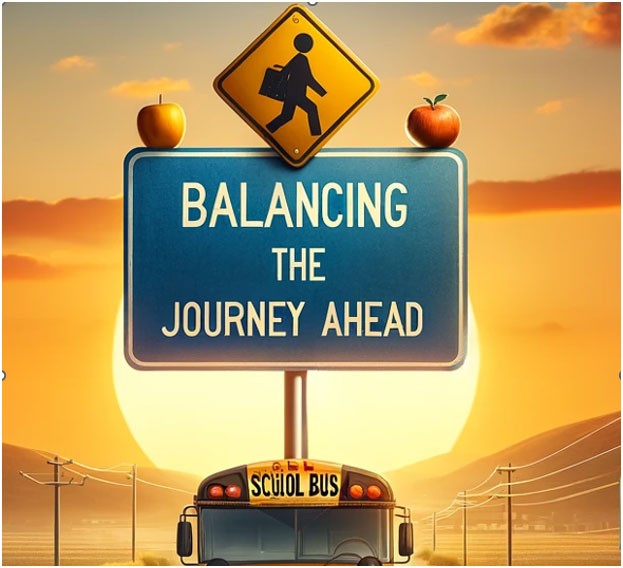
Image by Transfinder via Dall-E
Conclusion
Purchasing, maintaining, and operating school buses involves a variety of costs. These take many forms, some obvious and others easier to overlook. Beyond the initial purchase cost, buses require regular maintenance and fuel. Personnel must be employed to operate, maintain, and oversee these unwieldy but necessary vehicles. Operational expenses and mandated regulatory compliance further inflate the true cost of ownership.
Most districts are at a crossroads to find a solution that provides an equitable balance between the services offered to students and the cost to the education system. Innovative software like route optimization and fleet management analytics help districts find this sweet spot.
Additionally, policy and priority changes may help schools find the balance they need to provide effective transportation services to their student population.
References
https://www.schoolbusfleet.com/10010945/a-closer-look-at-lifecycle-costs



